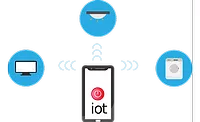Mobile and IoT Devices: Enabling Remote Access

As many industries adopt IoT solutions for increased security, reduced costs and new opportunities, the buildings industry is looking to do the same by incorporating IoT and mobile functionality into a range of facilities, including around building security systems. For a growing number of today’s security executives, understanding how to use new IoT-connected tools is now an important part of your job.
By properly understanding how to use these powerful tools, you can become far more efficient and effective than ever before. One of the most powerful examples of this is the use of remote monitoring tools – through remote monitoring, you can access all of your building’s security systems including video monitoring, intrusion detection and visitor management through mobile devices. Moving beyond the control room, security teams can stay visible throughout the entire facility while also monitoring real time information through devices connected to the cloud-enabled services. Security staff can make clearer decisions and provide faster responses by accessing this information at any time, from any place. And as security management tools continue to develop, you and your integrators need to be aware of how changing building security management, and how this affects your future.
The changing building management landscape
The International Facility Management Association (IFMA) estimates that with active controls and IoT-enabled technology, facilities can expect a 50 percent increase in cost efficiency, including energy, maintenance and other recurring costs. Providing facilities with IoT capabilities allows building managers to implement predictive maintenance and analytics technology, allowing facilities to save up to 20 percent per year on maintenance and energy costs. The use of IoT devices and services helps create intelligent buildings that minimize energy use, optimize the performance and lifespan of physical assets, and ensure the safety, security, and efficiency of the electrical system itself and of building tenants. And this is fast becoming a reality. For example, Navigant Research has predicted that the total number of smart devices in buildings has the potential to reach as many as 10 billion as soon as 2020.
As the use of cloud and IoT-enabled devices continues to grow, it is becoming more commonplace for you to have mobile devices connected to your building’s systems. As multiple industries integrate mobile devices into their daily workflows, giving more opportunities for the benefits of remote access to be realized, it is likely that mobile tools with remote access will become an increasingly important part of building security and management, as security teams consistently use their devices to monitor various aspects of their building to ensure their occupants’ safety.
Getting IoT Ready
Before integrating mobile or remote devices into everyday operations, you will need to ensure the proper steps have been taken to maximize operational efficiency. Whether for a large multi-national entity or a medium-sized business, you can deliver significant transformation to your security systems by implementing IoT enabled technology. Before fully implementing IoT into their workdays, you should take into account:
- Testing out the use of IoT: Before totally revamping a system to include IoT capabilities, organizations should start by taking small steps. For example, this could include employing a pilot project that focuses on a specific facet of the security system, such as video surveillance. However, keep in mind that this and other systems need to have end-to-end configurability.
- Build a solid plan: Outline the specific goals that the organization hopes to accomplish through an IoT-leveraged building management system through measurable achievements.
- Include all key stakeholders in the decision: Planning out IoT integration should involve all of a facility’s stakeholders to determine how and why the integration would be meaningful to them. The stakeholders should establish their own separate goals and objectives that align with the values and mission of the organization, in addition to evaluating ROI. After outlining the specific goals, you should collaborate with contractors and vendors to produce an effective implementation strategy.
- Technology integration and interoperability: Building managers should integrate IoT platforms holistically yet with a safe degree of separation. If the integration is siloed, systems may remain disparate despite the incorporation of IoT. The devices and systems must also be scalable, adaptable, and easy to integrate. Organizations may need to expand these systems in the future as new technologies emerge with more features and capabilities to consider.
- Intelligent data analysis: Advances in technology based systems can aggregate, filter, and translate large amounts of data, providing managers with actionable insights. As such, facilities managers and other employees need the proper training to both assess and analyze the data to make smart decisions.
Protecting buildings against outside threats: practical steps
In order to become IoT ready, it is also critical that IT teams implement IoT-based cybersecurity solutions, such as the use of dual authentication and encryption to protect communications between mobile devices, controllers, and workstations.
You are not alone in the effort to ensure that IoT-enabled systems for buildings are protected. This effort is being taken extremely seriously across the wider industry, and as IoT-connected building management systems become more popular, new standards and protocols are being implemented to ensure cybersecurity is maintained and managed across each system connected to mobile applications. For example, system manufacturers are incorporating threat modeling, secure code practices and extensive testing to ensure that their teams are following best practices. End users are providing security training to team members and even application developers to ensure system users are complying with company rules. In addition, many of you are also beginning to dedicate specific staff to cybersecurity teams to help provide installation services, maintenance and support with incidents or vulnerabilities.
As attacks become more common and sophisticated, businesses need to keep up to date with the latest solutions as hackers continue to familiarize themselves with existing security solutions and work around them. Evolving processes and procedures with changing security needs will be vital to ensuring facility success. Network managers should also plan to continually train staff to ensure cybersecurity systems and protocols continue to evolve and are continually updated and followed across the organization.
Looking ahead
The digital transformation of multiple industries, including the facilities industry, is creating a need for the adoption of IoT and mobile technology into everyday practices. Incorporating mobile devices into daily workflows has increased productivity among facility staff by enabling remote work, and new levels of efficiency and effectiveness for your security staff. As part of this, your vendors need to be cognizant of how this will affect the growing need for cloud solutions to include components that enable easy, quick and efficient access to databases and security systems from the palm of a security professional’s hand.
Prior to implementing IoT-enabled platforms, ensure that you have the proper ability to do so by undergoing a thorough planning and testing process, including employing pilot programs and assessing the goals of each stakeholder. By having the tools to work from anywhere at any time, buildings can be more secure than ever.
Looking for a reprint of this article?
From high-res PDFs to custom plaques, order your copy today!






